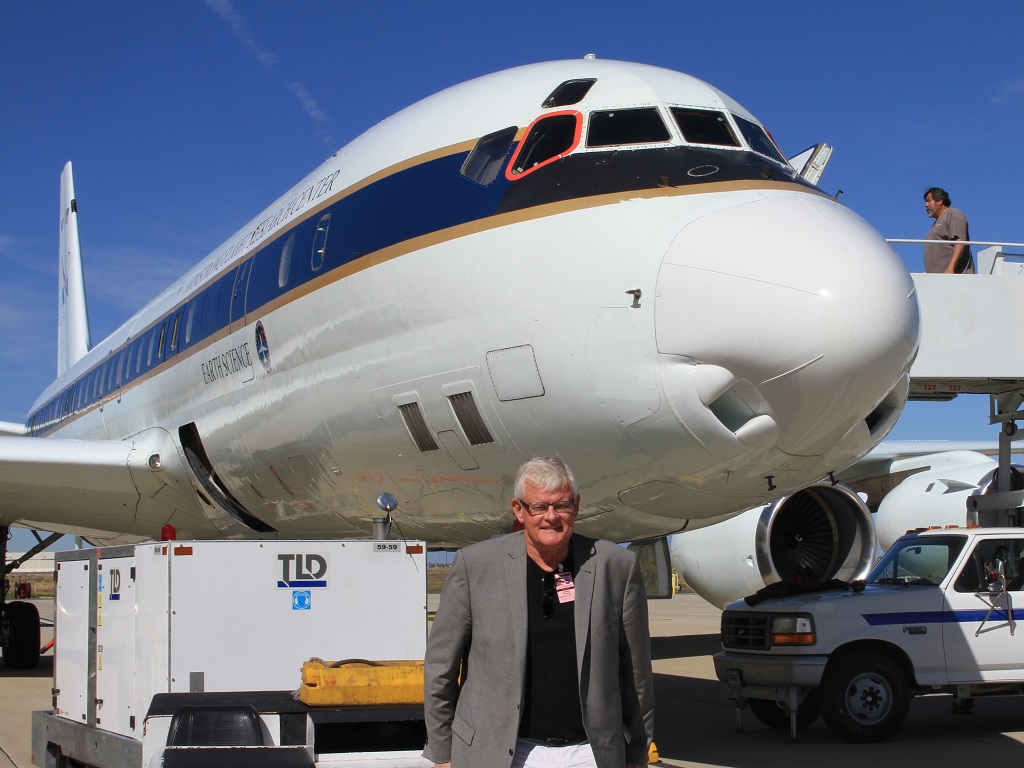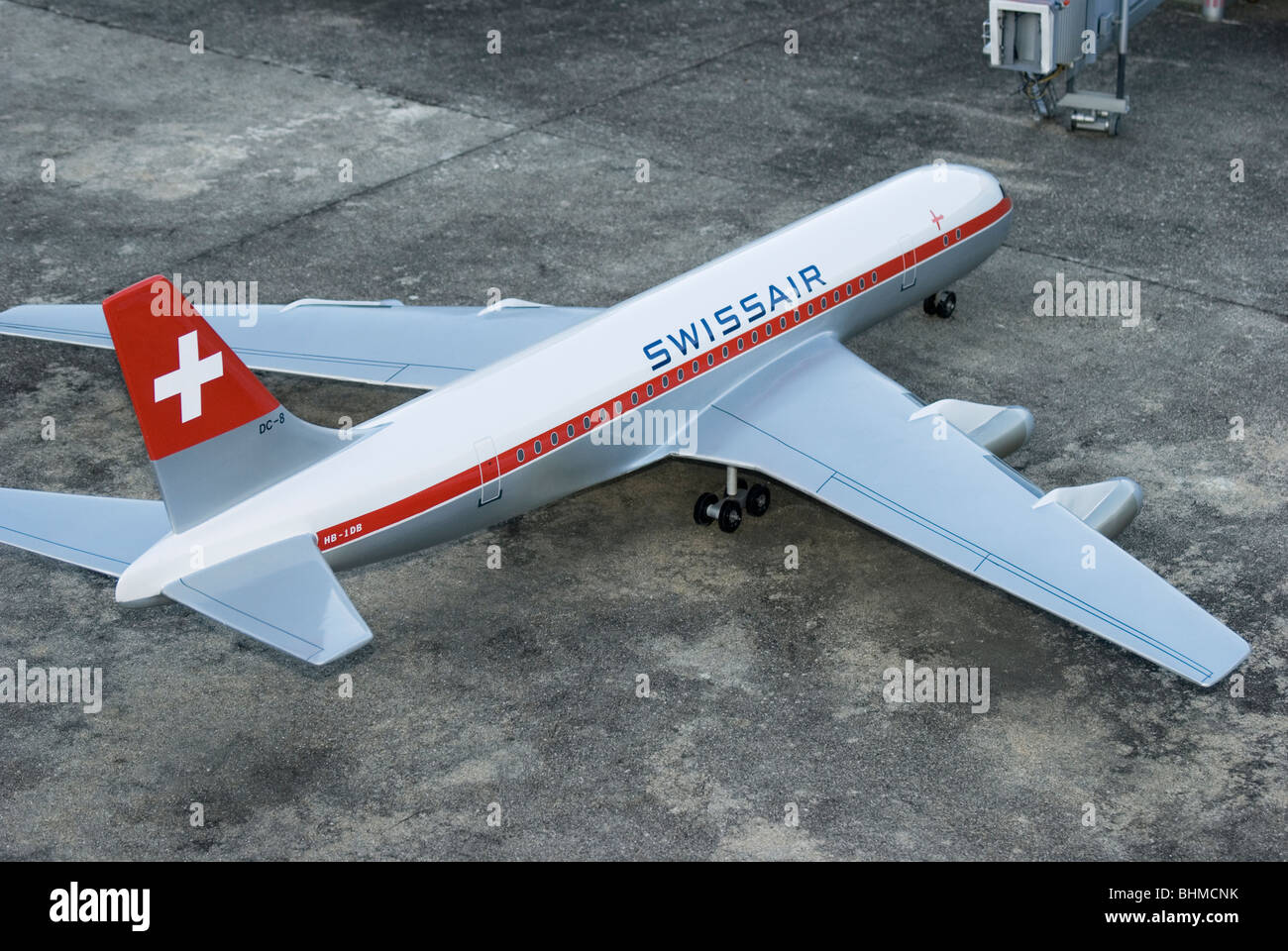Dc 8 Aircraft - The DC-8 is a low-wing quadjet aircraft redesigned with CFM56s. This DC-8, photographed in 2007, belongs to NASA.
The Douglas DC-8 (sometimes called the McDonnell Douglas DC-8) is a long-range narrow-gauge airliner manufactured by the American Douglas Aircraft Company. After losing the May 1954 Air Force Tank Competition to the Boeing KC-135, Douglas announced his proposed jetliner in July 1955. In October 1955, Pan Am placed its first order in competition for the Boeing 707, followed by several aircraft. The first DC-8 entered service at Long Beach Airport on April 9, 1958, and made its maiden flight on May 30. FAA certification was achieved in August 1959, and the DC-8 entered service with Delta Air Lines on September 18.
Dc 8 Aircraft

The six-wing, low-wing aircraft was a jet aircraft with four wings, and the first version was 151 feet (46 m) long. The DC-8-10 was powered by Pratt & Whitney JT3C turbojets and had a MTOW of 273,000 lb (124 t), while the DC-8-20 had more powerful JT4A turbojets at a MTOW of 276,000 lb (125 t). Intercontinental models were fueled up to 315,000 lb (143 t) MTOW, with JT4As for the Series 30 and Rolls-Royce Conway turbofans for the Series 40. The Pratt & Whitney JT3D carried the later DC-8 -50 and cargo models. 325,000 lb (147 t).
Dc 8 Dedication
In April 1965, the revised Series 60 was announced. The DC-8-61 is extended 36 feet (11 m) in compact configuration for 180–220 seats and 325,000 lb (147 t) MTOW. Began flying on 14 March 1966, certified on 2 September 1966, and entered service with United Airlines in February 1967. In April 1967, the long-range DC-8-62 was extended by 7 feet (2.1 m). It can seat 189 passengers at a range of 5,200 nmi (9,600 km) with a large wingspan of up to 350,000 lb (159 t) MTOW. The DC-8-63 had a longer fuselage and larger wing, and MTOW cargo vehicles reached 355,000 lb (161 t).
The DC-8 produced 556 aircraft until 1972. It was replaced by larger wide-body aircraft, including Douglas's DC-10. In 1975, the Series 70 retrofit was introduced with a quieter and more fuel-efficient CFM56 turbofan. Some recycled materials are still in use.
After World War II, Douglas was the leading aircraft manufacturer in the commercial aircraft market. Although Boeing introduced the new all-metal Model 247 airplane in 1933 and produced a staggering number of the four-engined B-17 and advanced B-29, the long-suppressed Douglas, more aircraft manufacturers, post-defined. Combat Aviation Industry.
During the 1930s, 1940s, and 1950s, Douglas built a series of piston engine airplanes (DC-2, DC-3, DC-4, DC-5, DC-6, and DC-7). When de Havilland flew the first jet plane, the Comet, in 1949, Douglas initially refused to build a jet plane.
Mcdonnell Douglas Dc 8 71 73f
In 1952, the first de Havilland Comet entered service. At first it was a success, but after two fatal accidents in 1954 it was brought to a standstill by sudden exhaustion. Aircraft manufacturers benefited greatly from the Comet's principles, which led to the full adoption of the pressure building design of the DC-8.
In 1952, the Douglas remained the most successful commercial airliner. The company received around 300 orders for the piston-engined DC-6 and its successor, the DC-7. The Comet disasters and the recent shortage of jet aircraft seemed to confirm the decision to stick with propeller-driven aircraft.
As early as 1949, Boeing took the bold step of planning a pure-jet aircraft. Boeing's military division was already familiar with large long-range jets with the B-47 Stratojet (first flight 1947) and the B-52 Stratofortress (1952). ). With thousands of fighter jets planned or operational, Boeing established a close relationship with the US Air Force's Strategic Air Command (SAC). Boeing also supplied SAC with refueling aircraft and piston-engine KC-97 Stratofrighters, but these were slow and underpowered to work with the new jets. The B-52, in particular, had to drop from its cruising altitude and nearly stall to engage the KC-97.

Believing that the need for a jet-powered ship was real, Boeing began building a new jet engine for this part that could be turned into an airplane. As for the aircraft, it will have a similar landing area to the Comet, but its swept wing will give it a higher cruising speed and better range. Launched in 1950 as the Model 473-60C, Boeing failed to attract interest from aviation. Boeing was convinced that the project was important and decided to continue with the Boeing 367-80 ("Dash-80") model. After spending $16 million in construction, the Dash-80 took off on May 15, 1954, and flew the following month. Boeing's plans are clear despite the misleading old model number.
Crash Of A Douglas Dc 8 62 Off Los Angeles: 15 Killed
In mid-1952, Douglas began conceptual studies of stealth transport. By mid-1953 these had evolved into the final DC-8; 80-seat, low-wing aircraft with four Pratt & Whitney JT3C turbojets, 30° wingspan, 11 ft (3.35 m) interior cabin diameter to allow for five-aspect seating. Weight was to be 190,000 lb (86 metric tons), and range was estimated at 3,000–4,000 mi (4,800–6,400 km).
Douglas was tight-lipped about the jet plan, but agreed that, like many of the USAF's transportation contracts, the Air Force tanker contract would go to two companies for two separate aircraft. In May 1954, the USAF announced a requirement for 800 jet tanks to Boeing, Douglas, Convair, Fairchild, Lockheed, and Martin. Boeing had just two months to put its prototype in the air. Just four months after submitting requirements for the fleet, the USAF ordered the first 29 KC-135 aircraft from Boeing. In addition to Boeing's ability to instantly refuel jets, the Flying-Boom air-to-air refueling aircraft was also a Boeing product derived from the KC-97.
Donald Douglas was surprised by the speed of the decision, which he said was taken before competing companies had time to finalize their bids. He protested in Washington to no avail. After starting the DC-8 project, Douglas decided it was better to continue than to give up. Negotiations with the airlines resulted in several changes: the fuselage was extended by 15 inches (38 cm) to allow seating for six; This led to larger wings and tail surfaces and a longer fuselage.
The DC-8 was announced in July 1955. Four models were initially offered, all with a 45.87-ft airframe and 141-ft-1-in (43.00 m) but differing in genetics and fuel capacity, and weighing 240,000–260,000. lb (109–118 metric tons). Douglas declined to provide another fuselage size. A maiden flight was planned for December 1957, with an attempt to return to service in 1959. Knowing full well that it was lagging behind Boeing, Douglas launched a massive marketing campaign.
United Airlines Douglas Dc 8 51 Ready To Depart Boston Editorial Stock Photo
It looks like Douglas' initial vision of the airline market will come true; The transition to turbine power seemed more turboprops than turbojets. The first 40-60-seat Vickers Viscount was in service and proved popular with passengers and aviators: it was faster, quieter and more comfortable than the piston-engined models. Another British competitor was the 90-seat Bristol Britannia, and Lockheed, Douglas' main competitor in the large aircraft market, was committed to the short- and medium-range turboprop Electra. Meanwhile, the comet remained stationary. See first-hand the huge economic and technical problems of jet aircraft. However, no one can avoid buying jets if their competitors do.
It lasted until October 1955, when Pan American World Airways placed simultaneous orders for 20 707s and 25 Douglas DC-8s. Buying one version of a powerful jet that had not been tested was brave: buying both was unthinkable at the time. In the final months of 1955, other airlines followed suit. The DC-8 was chosen by United Airlines, National Airlines, KLM, Eastern Airlines, Japan Airlines and Scandinavian Airlines System (SAS). In 1956, Air India, BOAC, Lufthansa, Qantas, and TWA added more than 50 to the 707 order book, while Douglas sold 22 DC-8s to Delta, Swiss, TAI, TransCanada, and UAT. By early 1958, Douglas had sold 133 DC-8s compared to Boeing's 150 707s.
First DC-8-10 in Douglas livery, 1959. The DC-8 first flew on May 30, 1958, and was certified in August 1959.

Donald Douglas proposed building and testing the DC-8 at Santa Monica Airport, the birthplace of the DC-3 and home to the Douglas factory, which employed 44,000 workers during World War II. To get the new jet, Douglas asked the city of Santa Monica, California
Douglas Dc 8 'le Sarigue', Electronic Reconnaissance Aircraft (le Bourget)
Douglas dc 8 aircraft, douglas dc 4 aircraft, aircraft dc motor, dc 9 aircraft, aircraft museum washington dc, dc 8 aircraft for sale, dc 10 aircraft for sale, aircraft dc generator, aircraft mechanic jobs in washington dc, 28v dc power supply for aircraft, dc 6 aircraft, dc aircraft